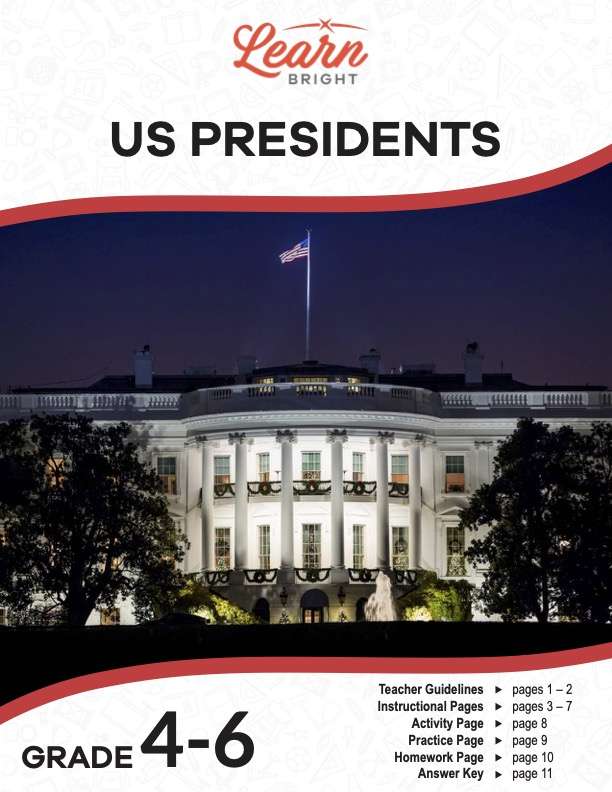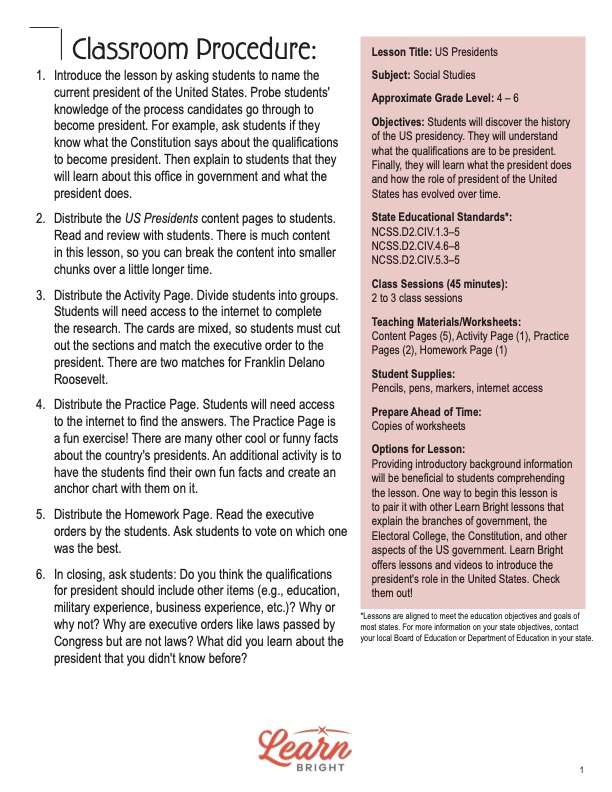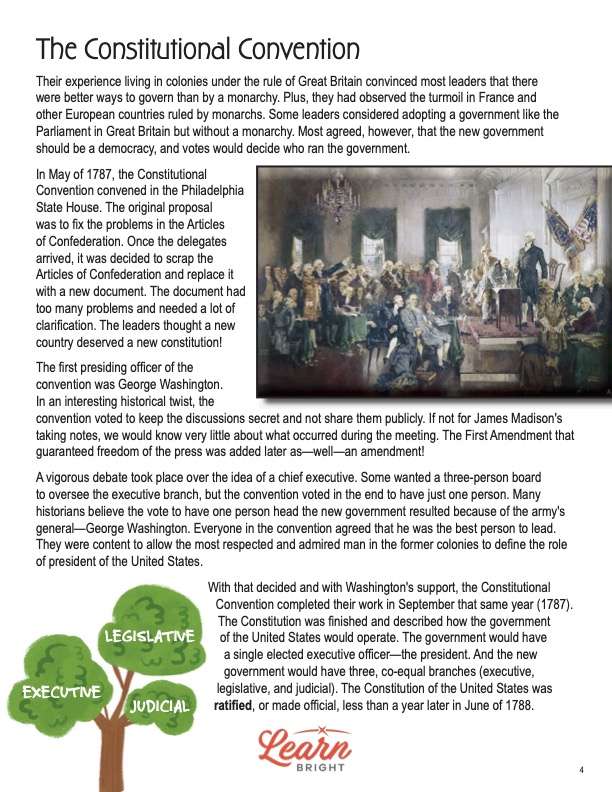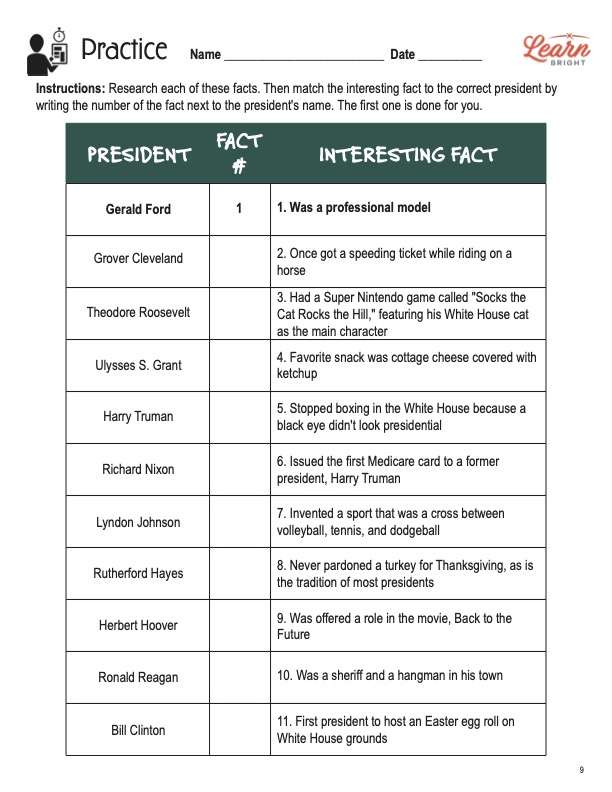Description
What our US Presidents lesson plan includes
Lesson Objectives and Overview: US Presidents teaches students about the history of the US presidency. Students will understand what the qualifications are to become president. They will discover the significance of the Electoral College. Finally, they will learn what the president does and how the role of president of the United States has evolved over time. This lesson is for students in 4th grade, 5th grade, and 6th grade.
Classroom Procedure
Every lesson plan provides you with a classroom procedure page that outlines a step-by-step guide to follow. You do not have to follow the guide exactly. The guide helps you organize the lesson and details when to hand out worksheets. It also lists information in the orange box that you might find useful. You will find the lesson objectives, state standards, and number of class sessions the lesson should take to complete in this area. In addition, it describes the supplies you will need as well as what and how you need to prepare beforehand. Ensure your students have internet access for this lesson.
Options for Lesson
The “Options for Lesson” section lists a number of suggestions for activities to add to the lesson or substitutions for the ones already in the lesson. Providing introductory background information will be beneficial to students comprehending the lesson. One way to begin this lesson is to pair it with other Learn Bright lessons that explain the branches of government, the Electoral College, the Constitution, and other aspects of the US government. Learn Bright offers lessons and videos to introduce the president’s role in the United States. Check them out!
Teacher Notes
The teacher notes page includes a paragraph with additional guidelines and things to think about as you begin to plan your lesson. This page also includes lines that you can use to add your own notes as you’re preparing for this lesson.
US PRESIDENTS LESSON PLAN CONTENT PAGES
Introduction to US Presidents
The US Presidents lesson plan includes five content pages. President of the United States is one of the world’s most demanding and complex jobs. The president is responsible for over 335 million US residents and is the “leader of the free world.” Since the First World War, US presidents have led the fight against communism and dictatorships. The United States is the principal organizer of NATO, has military bases in several countries, and encourages democracy as the best governing system in the world. The president of the United States is the face and voice of these efforts.
Why does the US have a president? What are the qualifications for the job of president of the United States? Who chooses the president and how? What does the job entail? How is the president of our country different from other countries’ leaders? These are great questions! Let’s begin with a history of why the United States has a president.
Recall early American history when the colonies began organizing and declared independence from Great Britain. Great Britain was ruled by a monarch or king and had an elected Parliament that enacted laws. Monarchs ruled most European countries. After the Revolutionary War (some call it the War for American Independence), leaders of the colonies met together to plan what type of government they thought would be best for the new country.
Their experience living in colonies under the rule of Great Britain convinced most leaders that there were better ways to govern than by a monarchy. Plus, they had observed the turmoil in France and other European countries ruled by monarchs. Some leaders considered adopting a government like the Parliament in Great Britain but without a monarchy. Most agreed, however, that the new government should be a democracy, and votes would decide who ran the government.
Constitutional Convention
In May of 1787, the Constitutional Convention convened in the Philadelphia State House. The original proposal was to fix the problems in the Articles of Confederation. Once the delegates arrived, it was decided to scrap the Articles of Confederation and replace it with a new document. The document had too many problems and needed a lot of clarification. The leaders thought a new country deserved a new constitution!
The first presiding officer of the convention was George Washington. In an interesting historical twist, the convention voted to keep the discussions secret and not share them publicly. If not for James Madison’s taking notes, we would know very little about what occurred during the meeting. The First Amendment that guaranteed freedom of the press was added later as—well—an amendment!
A vigorous debate took place over the idea of a chief executive. Some wanted a three-person board to oversee the executive branch, but the convention voted in the end to have just one person. Many historians believe the vote to have one person head the new government resulted because of the army’s general—George Washington. Everyone in the convention agreed that he was the best person to lead. They were content to allow the most respected and admired man in the former colonies to define the role of president of the United States.
With that decided and with Washington’s support, the Constitutional Convention completed their work in September that same year (1787). The Constitution was finished and described how the government of the United States would operate. The government would have a single elected executive officer—the president. And the new government would have three, co-equal branches (executive, legislative, and judicial). The Constitution of the United States was ratified, or made official, less than a year later in June of 1788.
Choosing the President
There are only three qualifications to be the president of the United States, which is surprising given how important the job is! The candidates must be at least 35 years old. They have to be a natural-born citizen of the United States. Finally, they must have lived in the US for at least 14 years.
The Supreme Court and years of elections has interpreted “natural-born citizen” as someone who was a US citizen at birth with no need to go through a naturalization proceeding at some later time. Naturalization is the process by which a person who moves to the United States from another country chooses to become a citizen of the US. It’s interesting to note that most founders were educated and had military experience, yet those qualifications are not in the Constitution.
In modern times, qualified voters vote for the president of the United States every four years. Unique to the US is that the president is not elected by direct vote. Additionally, several candidates can be on the ballot for president. The process of becoming president begins with the political parties. However, only two parties—Democratic and Republican—have consistently nominated candidates for president and successfully won elections since the early 1800s.
Candidates compete in party primaries. Voters vote in the primaries for the persons they think best represent their views. Once a candidate has accumulated the most votes in the primary, they go to a nominating convention. The delegates, or people attending the nominating convention, are chosen by a complex set of rules established by the national party rules committees. They vote to select the candidate to represent them in the national presidential elections. So, the first step is to campaign in primary voting and then be nominated by a political party!
The next step to becoming president is to campaign nationwide to convince voters to vote for you. Since 1845, election day has been the Tuesday after the first Monday in November. Why Tuesday? In early America, almost everyone worked on farms. Farmers finished harvesting crops by November and wouldn’t plant again until spring, making November the logical choice to hold the vote. For some people, it could take a day or two to travel to where they could place their vote. The weekend was not practical because people attended church services on Sunday. Wednesday was not an option since it was the day the farmers went to the market, leaving Tuesday as the only choice!
Electoral College
The US Presidents lesson plan then explains the election process. In the US, voting for president is unique. While voters do vote, they do not actually vote directly for the president. In a direct voting system, the candidate with the most votes wins. In US presidential elections, that’s not the case. The writers of the Constitution were concerned about states with large populations having too much influence in presidential elections. And some early leaders did not trust voters to make good decisions. The delegates looked for a compromise and came up with a novel idea.
Written into the Constitution is the Electoral College, a compromise between the election of the president by a vote in Congress and by a popular vote, a vote by qualified citizens. When voters select the person they want for president, they really vote for how the electors in the Electoral College will vote, not for the president directly.
Under the Constitution, members of Congress are apportioned or allocated according to the population in the state. For example, California has more members in Congress than Maine. The Electoral College votes are apportioned to each state by the number of members of Congress.
There are 538 electoral votes possible. To be president, a candidate must get at least 270 electoral votes. In most elections, whoever gets the majority (the most) of the popular vote is the winner. Usually the majority is 51%, but it can be lower in some cases (plurality). But this is not the case in presidential elections. What is unique in US presidential elections is that a candidate can get a majority of the popular vote and still not be elected president! That means it is also possible to get 270 or more electoral votes without getting most of the popular votes in the election.
Have there ever been elections where most Americans voted for one presidential candidate in the popular vote, but the other candidate became president because they had the most Electoral College votes? Yes, it has happened five times and will probably happen again.
Role of the President
You learned earlier that the United States Constitution defines what each of the three branches of government does. The next part of the US Presidents lesson plan reviews what those jobs are. The executive branch includes the president and administrative cabinets. They manage the government. In the legislative branch are the House of Representatives and the US Senate. They make laws and determine the national budget. Finally, the judicial branch—Supreme Court and federal courts—interpret the laws.
In the Oath of Office, the Constitution states that the president’s supreme responsibility is to “preserve, protect, and defend the Constitution of the United States.” It explains that the president is the head of state, the head of the US government, and the commander in chief of the armed forces. In addition, the president enforces the laws that Congress passes. Because of these various roles, the president has several responsibilities:
The president represents the US to foreign governments and negotiates treaties. They oversee the cabinets and the administration of day-to-day operations. They also oversee the military, but they must have Congress’s approval to declare war. Finally, the president must implement new laws when Congress passes them.
Over time, the office of the president has grown to include other jobs that the Constitution does not mention. For example, during a national disaster, the president can direct financial aid and assistance to the area without the approval of Congress. The president can issue executive orders or require the government to do certain things through regulations. Only Congress makes laws, but the president can veto or send a law back to Congress for changes. Though head of the military, the president needs congressional approval to declare war. The president is sometimes called the Chief Citizen, symbolizing all citizens as an example of civic behavior.
Since the earliest days of the US, when George Washington was chosen as the first president, the office has grown in importance as the country expanded. Presidents have served in times of peace, war, and social change. While they are from different parties with different ideas, our presidents have shared a strong vision for America’s place in the world and a desire to serve the interest of the American people.
US PRESIDENTS LESSON PLAN WORKSHEETS
The US Presidents lesson plan includes three worksheets: an activity worksheet, a practice worksheet, and a homework assignment. You can refer to the guide on the classroom procedure page to determine when to hand out each worksheet.
EXECUTIVE ORDERS ACTIVITY WORKSHEET
Students will learn about some of the executive orders passed by past presidents. They must cut out the pieces on the worksheet and match each order to the president who issued it. There is a question at the bottom of the worksheet that they can answer at some point during the activity.
INTERESTING FACTS PRACTICE WORKSHEET
For the practice worksheet, students will match facts and presidents. There are 11 facts, one of which is already done. Students will research the facts to find out which one applies to each president in the list.
US PRESIDENTS HOMEWORK ASSIGNMENT
The homework assignment requires students to create their own executive order. Students will imagine themselves as president of the United States and issue an executive order. They will then explain why it is beneficial to the US citizens.
Worksheet Answer Keys
This lesson plan includes an answer key for the practice worksheet. Correct answers are in red to make it easy to compare them with your students’ responses. If you choose to administer the lesson pages to your students via PDF, you will need to save a new file that omits this page. Otherwise, you can simply print out the applicable pages and keep this as reference for yourself when grading assignments.









